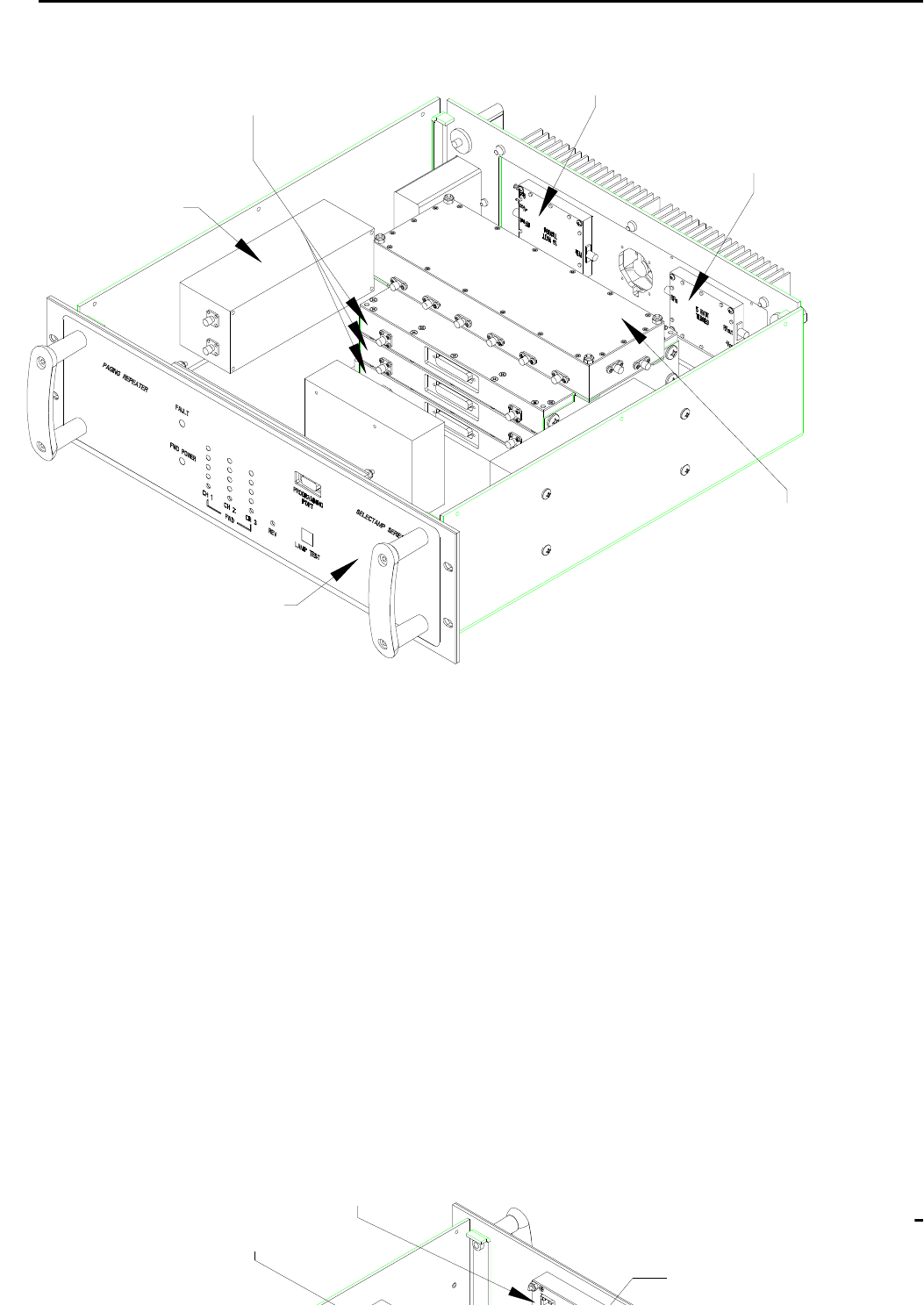Andrew NBPCS-9002W Channelized Paging Repeater User Manual Exh D Chapter 3
Andrew Corporation Channelized Paging Repeater Exh D Chapter 3
Andrew >
Contents
Exh D Chapter 3

AE02B-A3659 Rev -- FUNCTIONAL DESCRIPTION
Document use is restricted to that described on cover 3-1
CHAPTER 3
FUNCTIONAL DESCRIPTION
3.1 OVERVIEW
The SelectAmp Channelized Paging Repeater accepts inputs in the 928 – 942 paging band, and selectively
passes one discrete channel in each band while rejecting the others. In the forward channels this is
accomplished by downconverting the desired signals to a 45 MHz intermediate frequency and using
narrowband crystal filters to provide adjacent channel rejection. The reverse path is not channelized,
passing all frequencies in the 897 – 903 MHz band.
3.2 FUNCTIONAL DESCRIPTION
Refer to Figure 3-1. The amplifier contains two paths; forward for the base station to pager signal and
reverse for the pager to base station signal. The forward path includes a diplexer, low noise amplifier and
splitter, channelizer, combiner, and power amplifier. The channelizers determine the frequencies to be
amplified and provide the gain control. The reverse path includes a diplexer, broadband module (amplifier
and filters), and a power amplifier. Diplexing of the forward and reverse channels is accomplished by
diplexer filters tuned to the appropriate frequencies.
3.2.1 DIPLEXER
The diplexer module consists of dual filters with a common port on one end and two separate ports on the
other. One side of the diplexer is tuned for the forward channel, the other side for the reverse channel.
Insertion loss of each filter is 2 dB maximum and 65 dB minimum rejection to the opposite band.
3.2.2 BROADBAND MODULE
The broadband module contains three boards, each mounted in its own compartment. The forward channel
signals are routed through the LNA/Splitter and Combiner boards. The reverse channel signal is routed
through the 901 MHz board. Each board is described in more detail below.
3.2.2.1 LNA/SPLITTER
The LNA/Splitter module contains the first active devices in the forward channel path. It consists of a low
noise amplifier, 3-way power splitter, and a gain stage and filter per path. The amplifiers bias voltages are
monitored for a fault condition and reported to the control/distribution module.
3.2.2.2 COMBINER
The Combiner module consists of a 3-way power combiner, a gain stage and filter, and a level detector
circuit.

AE02B-A3659 Rev -- FUNCTIONAL DESCRIPTION
Document use is restricted to that described on cover 3-2
Figure 3-1. SelectAmp NBPCS-900-3 Outline Drawing, front view.
3.2.2.3 901 MHZ REVERSE CHANNEL
The 901 MHz reverse channel module provides four gain stages, filtering, and gain adjustment via the front
panel.
3.2.3 CHANNELIZER
The channelizer module contains three boards, each mounted in their own compartment. These three
boards, which are described below, provide the channel selectivity. The channelizer module gain is
approximately 40 dB.
CHANNELIZERS (A4,A5,A6)
DIPLEXER (A8)
FRONT PANEL (A13)
BROADBAND (A7)
FWD CHANNEL PA (A12)
REV CHANNEL PA (A10)
CONTROL/DISTRIBUTION (A1)
DIPLEXER (A9)
POWER SUPPLY (A2)

AE02B-A3659 Rev -- FUNCTIONAL DESCRIPTION
Document use is restricted to that described on cover 3-3
Figure 3-2. SelectAmp NBPCS-900-3 Outline Drawing, rear view.
3.2.3.1 DOWNCONVERTER
The downconverter board consists of a mixer driven by a synthesizer, a crystal filter centered at 45 MHz
with either a 12.5 KHz (930 MHz channelizer), a 50 KHz (940 MHz ReFlex50 channelizer), or a 25 KHz
(940 MHz ReFlex25 channelizer) 1 dB bandwidth. It has one fixed gain stage, and a variable gain stage
to provide overall gain adjustment. A Receive Signal Strength Indicator (RSSI) circuit measures the
received signal strength and outputs a dc voltage to the Control/Distribution board. The DC current draw
of each gain stage is monitored by a window comparator. The window comparator indicates a fault, if the
gain stage has an open or short condition. The output of the down converter is fed to the upconverter
board.

AE02B-A3659 Rev -- FUNCTIONAL DESCRIPTION
Document use is restricted to that described on cover 3-4
3.2.3.2 UPCONVERTER
The upconverter board mixes the filtered 45 MHz IF with a signal from the synthesizer and outputs the
same frequency that was input to the downconverter. The upconverter consists of a mixer, gain stage, and
filter. The DC current draw of each gain stage is monitored by a window comparator. The window
comparator indicates a fault, if the gain stage has an open or short condition.
3.2.3.3 SYNTHESIZER
The synthesizer board consists of a synthesizer circuit that is driven by a reference oscillator and distribution
amplifiers. The synthesizer operating frequency is programmed from the Control/Distribution module. The
forward channel frequencies are set with a computer that has Andrew designed frequency control software
installed on it. This software is a Microsoft Windows 95/98/NT application that allows the operator to input
the desired channel frequency. The Control/Distribution module converts the operator's input to the
appropriate frequency command for the synthesizer. The output of the synthesizer is divided into a
downconverter path and an upconverter path.
3.2.4 POWER SUPPLY
The power supply assembly consists of a Power Entry Module and switching power supply. The power
supply accepts a 100 to 240 VAC, 3A, 50/60 Hz input and outputs +15 VDC for use by the rest of the amplifier.
Power is distributed to the active modules through the Control/Distribution board.
3.2.5 CONTROL/DISTRIBUTION MODULE
The control/distribution module distributes power to the other modules, receives and processes status and
fault information, and provides forward channel frequency control. Power distribution consists of current
monitoring of both the forward and reverse channel PA’s, linearly regulating the +15 VDC down to +12 and
+5 VDC for various modules. Status functions include monitoring RSSI voltages from the channelizers,
monitoring forward output power, and driving the appropriate front panel LED’s. Channel frequency
selection information is received via RS-232 from the front panel and is processed by an on board
microcontroller. This information is also stored in ROM (Read Only Memory), so that frequency settings
are not lost if AC input power is lost. The microcontroller sends the frequency information via a three wire
interface to the appropriate channelizer. Various faults on the channelizers, broadband, and the
control/distribution module itself are monitored and displayed on the front panel. A rear panel contact
closure (closed when unit is operating normally) is provided for external monitoring.
3.2.6 POWER AMPLIFIER MODULES
The power amplifier module provides the final gain and power stages for the amplifier. A 5 Watt Peak Class
A linear amplifier is used for the forward channel. This 5 Watt unit has approximately 27 dB gain. A 1.6
Watt Peak Class A linear amplifier is used for the reverse channel. The 1.6 Watt unit has approximately
30 dB gain. The DC current draw of each power amplifer is monitored by a window comparator.

AE02B-A3659 Rev -- FUNCTIONAL DESCRIPTION
Document use is restricted to that described on cover 3-5
3.3 PROGRAMMING
The amplifier forward channels are set by connecting a laptop computer with the supplied cable to the front
panel connector.
Details on setting the channels and software operation are provided in Appendix B.